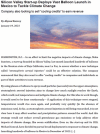Like diamonds in the sky? Public perceptions, governance, and information framing of solar geoengineering activities in Mexico, the United Kingdom, and the United States
- PMID: 38868558
- PMCID: PMC11166051
- DOI: 10.1080/09644016.2023.2301262
Like diamonds in the sky? Public perceptions, governance, and information framing of solar geoengineering activities in Mexico, the United Kingdom, and the United States
Abstract
Solar geoengineering (also known as solar radiation modification) is garnering more attention (and controversy) among media and policymakers in response to the impacts of climate change. Such debates have become more prominent following the first-ever field trials of stratospheric aerosol injection (SAI) in 2022. How the lay public perceives solar geoengineering remains unclear, however. We use nationally representative samples (N = 3013) in Mexico, United States, and United Kingdom to examine public perceptions of risks and benefits, support, and policy preferences. We also employ an information-framing design that presented individuals with media-style reports on SAI activities differing along three dimensions: location, actor, and scale and purpose. Support for SAI is found to be generally higher in Mexico; perceptions of risks and benefits do not differ between countries. Information about SAI activities has a limited effect. There is evidence that activities conducted by universities receive more support than those by start-up companies.
Keywords: Climate change; Global South; governance; public perception; solar geoengineering; stratospheric aerosol injection.
© 2024 The Author(s). Published by Informa UK Limited, trading as Taylor & Francis Group.
Conflict of interest statement
No potential conflict of interest was reported by the authors.
Figures
Similar articles
-
Exposure to climate change information predicts public support for solar geoengineering in Singapore and the United States.Sci Rep. 2023 Nov 14;13(1):19874. doi: 10.1038/s41598-023-46952-w. Sci Rep. 2023. PMID: 37963957 Free PMC article.
-
Impacts of hemispheric solar geoengineering on tropical cyclone frequency.Nat Commun. 2017 Nov 14;8(1):1382. doi: 10.1038/s41467-017-01606-0. Nat Commun. 2017. PMID: 29138402 Free PMC article.
-
Solar geoengineering to reduce climate change: a review of governance proposals.Proc Math Phys Eng Sci. 2019 Sep;475(2229):20190255. doi: 10.1098/rspa.2019.0255. Epub 2019 Sep 4. Proc Math Phys Eng Sci. 2019. PMID: 31611719 Free PMC article. Review.
-
Potential for perceived failure of stratospheric aerosol injection deployment.Proc Natl Acad Sci U S A. 2022 Oct 4;119(40):e2210036119. doi: 10.1073/pnas.2210036119. Epub 2022 Sep 27. Proc Natl Acad Sci U S A. 2022. PMID: 36166478 Free PMC article.
-
Are persistent aircraft trails a threat to the environment and health?Rev Environ Health. 2021 Jul 7;37(3):407-421. doi: 10.1515/reveh-2021-0060. Print 2022 Sep 27. Rev Environ Health. 2021. PMID: 34233386 Review.
Cited by
-
A new hope or phantom menace? Exploring climate emotions and public support for climate interventions across 30 countries.Risk Anal. 2025 Aug;45(8):2323-2340. doi: 10.1111/risa.17713. Epub 2025 Mar 15. Risk Anal. 2025. PMID: 40089455 Free PMC article.
-
Media frame development of direct air capture 2011-2023: A comparative analysis of Europe and North America.iScience. 2024 Nov 12;27(12):111360. doi: 10.1016/j.isci.2024.111360. eCollection 2024 Dec 20. iScience. 2024. PMID: 39634566 Free PMC article.
References
-
- American Geophysical Union , 2023. Position statement on climate intervention. American Geophysical Union. https://www.agu.org/share-and-advocate/share/policymakers/position-state....
-
- Asayama, S., Sugiyama, M., and Ishii, A., 2017. Ambivalent climate of opinions: tensions and dilemmas in understanding geoengineering experimentation. Geoforum, 80, 82–92. doi:10.1016/j.geoforum.2017.01.012 - DOI
-
- Biermann, F. and Möller, I., 2019. Rich man’s solution? Climate engineering discourses and the marginalization of the global south. International Environmental Agreements: Politics, Law and Economics, 19 (2), 151–167. 10.1007/s10784-019-09431-0 - DOI
LinkOut - more resources
Full Text Sources

